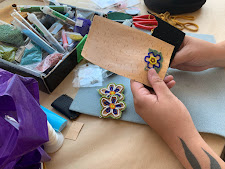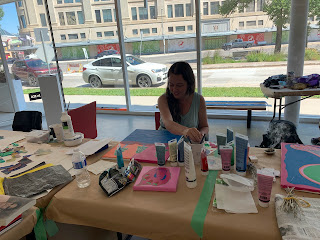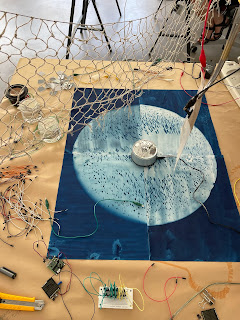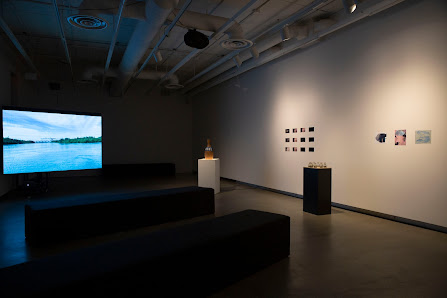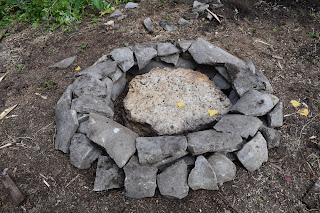Plug In ICA Summer Institute
August 24, 2022
Misipawistik Culture Camp : Photograph Sharing from the Camp
Second week of Summer Institute: Studio Time
Open Studio Photographs
Summer Institute 2022 : Water Knowledge
KC Adams is a Winnipeg-based artist who graduated from Concordia University with a B.F.A in studio arts. Adams has had several solo exhibitions, group exhibitions and been in three biennales including the PHOTOQUAI: Biennale des images du monde in Paris, France. Adams participated in residencies at the Banff Centre, the Confederation Art Centre in Charlottetown, the National Museum of the American Indian and the Parramatta Arts Gallery in Australia. Her work is in many permanent collections Nationally and Internationally. Twenty pieces from the Cyborg Hybrid series are in the permanent collection of the National Art Gallery in Ottawa and four trees from Birch Bark Ltd, are in the collection of the Canadian Consulate of Australia, NSW. She was the scenic designer for the Royal Winnipeg Ballet’s Going Home Star: Truth and Reconciliation. She helped design a 30-foot public art sculpture called Niimamaa for the Winnipeg Forks and a piece for the United Way of Winnipeg called Community. Adams was awarded the Winnipeg Arts Council’s Making A Mark Award and Canada’s Senate 150 medal recipient for her accomplishments with her Perception Photo Series. KC is now an author with her book Perception: A Photo Series that Quill & Quire chose as a 2019 Book of the Year.
PARTICIPANTS:
Erika-Jean Lincoln is an artist, researcher, and mentor living in Winnipeg-Treaty 1 territory. Over the past 20 years she has been challenging conventional knowledges and ideologies embedded in symbols, systems, and objects. Her method of art-making speaks from a perspective of cognitive difference in the style of non-conformity, un-doing, mis-fitting, and troubling. Erika-Jean has been awarded multiple grants over the years enabling her to learn, speculate, and make. She continues to exhibit and attend residencies near and far.
Kylie Hoydalo is a Métis artist and art educator living on Treaty 1 Territory. Her work explores ceramic processes and how clay nurtures the relationship between communities and their connection to the land. Kylie seeks to challenge the traditional shapes and functions of ceramics through rethinking wheel throwing, hand building and sculptural techniques. As an educator, her practice is deeply connected to working with the community and facilitating accessible art opportunities for children and adults. Kylie believes that utilizing art with the community is a practice that allows for social justice, fostering deeper connections and permits artists of differing backgrounds and capacities to reach their true potential.
My written name is Megan Lindell and my spirit name is Eagle Moon Woman. I am Anishinaabe-Metis and from Turtle Clan. I did not grow up learning about my culture, however, I now walk in a way where it guides me each day. I began to learn about Anishinaabe teachings, next I began to bead with the Louis Riel Institute, and finally, I began to teach. Years later, I began to paint the Woodland style of painting when a host in France asked me to paint for them. What I create through painting comes through the guidance of spirit and represents relatedness and life. I am thankful and amazed when a vision of a painting comes to me. I enjoy creating and sharing in a way that I am hopeful helps others. Even it if is only one person, I know that I have done what I needed to do. I work to share the truths of Creation that may not commonly be known about. I share my truth and I give from my heart with hope for positive change that respects Indigenous world views. I have also began to create my paintings with a focus on having the ability to meditate with them and to receive or let go of what one needs. I believe that through creating, we are giving new life. It is up to us how we give it.
Natasha Gusta was born in 1989 on Treaty One Territory. Her studies in Fine Arts were completed at the University of Manitoba and Temple University’s Tyler School of Art. She now divides her time between Winnipeg and the Kenora area. Her current work is comprised of a series of painted objects that reference household items of everyday significance and utility. Moving forward, she will aim to broaden the scope of this work, both materially and conceptually, to better understand the impact of colonization along the Winnipeg River.
Nishina Shapwaykeesic-Loft is a Kanien’kehá:ka woman from Tyendinaga Mohawk Territory. She is a queer, multi-disciplinary artist in a wide spectrum of mediums. She has a Bachelor of Fine Arts with Honours from York University in Theatre Production and Design. She works in the film, theatre, and mural arts industries. She continues to grow within her field and explore new opportunities.
Rachel Bach is Ktunaxa from ʔakisq̓nuk First Nation. She is fiercely committed caring for pregnant folks and their families and working towards the growth of community-based Indigenous midwifery care. Rachel works as a registered midwife at Mount Carmel Clinic in Winnipeg’s North End and as an Instructor in the Bachelor of Midwifery program at the University of Manitoba. Rachel completed the Midwifery Education Program at the Toronto Metropolitan University (formerly Ryerson University) but her heart is in Manitoba where she completed her Bachelor of Arts at the University of Manitoba and Masters in Development Practice in Indigenous Development at the University of Winnipeg. Her community work and research experience demonstrate a decade long commitment to reproductive safety and culturally-based care for Indigenous women and pregnant people.
Robyn Adams is a multi-disciplinary Red River Métis artist from Winnipeg, Manitoba. Her Métis family is from la Rochelle and St. Pierre Manitoba. She is currently a dual Masters of Architecture and Landscape Architecture student at the University of British Columbia and holds an Bachelor of Fine Arts Honours from the University of Manitoba focusing on sculpture and film photography. Her work researches Indigenous Knowledge and connecting the environment with architecture and identity through connection to the land, spirituality, and ancestry. She enjoys fishing, medicine picking, travelling, and making things with her hands.
Sarah Crawley works with ideas generated from lived experience using different photographic technologies and materials as she stubbornly clings to analog film and alternative photography techniques. Crawley’s approach invites unintended consequences through material use and process as she purposely gives up control, embracing and encouraging the accidental during both capture and processing. Her recent investigations examined the impact vulnerability and personal loss have on identity and she is currently exploring ideas around healing, resilience and reciprocal actions through the creation of plant-based anthotype prints. Crawley has exhibited large-scale prints, installations and book works across Canada in solo and group shows as well as internationally; her work is held in several public collections including the Banff Centre for the Arts, the City of Winnipeg, the Province of Manitoba and the Canadian Government. She acknowledges living on and engaging with Treaty One Territory, the original lands of Anishinaabeg, Cree, Oji-Cree, Dakota, and Dene peoples, and the Homeland of the Red River Métis Nation.
Shaneela Boodoo is a graduate of the University of Manitoba with a BFA (Honours) in Design. She is a second-generation immigrant, born and based in Winnipeg, Manitoba, and identifies as Indo-Caribbean. As an emerging artist, designer, and curator, Boodoo explores themes such as colonialism, displacement, and womanhood. Boodoo has also worked to establish and brand many BIPOC collectives in the city, such as RIND, Patterns Collective and Chroma Collective. She has curated shows such as Adornment and Analogous that centered the experiences of BIPOC in institutional spaces, such as the School of Art Gallery.
Skye Callow is an interdisciplinary artist who works within a spectrum of mediums, with a focus on installation, lens based media, sound, and performance. She engages in the corporeal nature of being in relation to the earth; a motif of ecology, self, and the land continuously presents itself. She delves into the idea of future ecologies with a current interest in the relationship and merging of natural and synthetic materials. In understanding these relationships, it allows the conceptualization of evolved futures and a view of how that would take shape. She is currently based in Winnipeg, Manitoba and has recently received her BFA (Hons.) from the University of Manitoba (class of 2022).
Acknowledgements
We are on Treaty 1 Territory. Plug In ICA is located on the territories of the Anishinaabeg, Cree, Oji-Cree, Dakota, and Dene peoples, and the homeland of the Métis Nation.
Plug In ICA extends our heartfelt gratitude to our generous donors, valued members, and dedicated volunteers. We acknowledge the sustaining support of our Director’s Circle. You all make a difference.
We would like to The Winnipeg Foundation for their ongoing support of Plug In ICA.
We gratefully acknowledge the support of the Canada Council for the Arts, the Manitoba Arts Council and Winnipeg Arts Council. We could not operate without their continued financial investment and lobbying efforts.
Plug In ICA relies on community support to remain free and accessible to all, and enable us to continue to present excellent programs. Please consider becoming a member of Plug In ICA and a donor at plugin.org/support or by contacting Erin Josephson-Laidlaw at erin@plugin.org.
For more information about our programming, contact Luther Konadu at luther@plugin.org.
For general information, please contact: info@plugin.org or call 1.204.942.1043.
September 3, 2019
Summer Institute 2019 Session 2. Indigenous Architectures.
Summer Institute 2019. Indigenous Architectures. Found objects on Site location. Objects used as main construction pieces for Installations.









